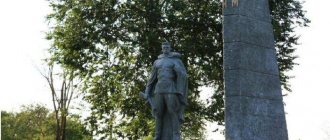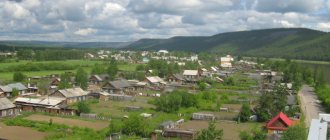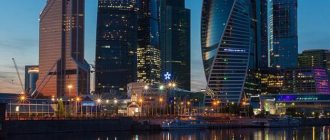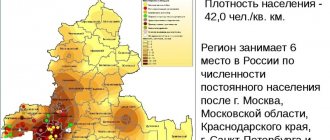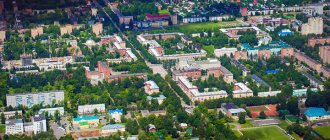For other places with the same name, see Obluchye.
City in Jewish Autonomous Oblast, Russia
| Obluchye Obluchye | |
| City [1] | |
| Location Obluchye | |
| Obluchye Location Obluchye Show map of Russia Obluchye Obluchye (Jewish Autonomous Region) Show map of the Jewish Autonomous Region | |
| Coordinates: 49°01'N 131°03'E / 49.017°N W. 131.050°E / 49.017; 131 050 Coordinates: 49°01'N 131°03'E. / 49.017 ° N W. 131.050°E / 49.017; 131 050 | |
| A country | Russia |
| Federal subject | Jewish Autonomous Region [1] |
| Administrative region | Obluchensky district [1] |
| Based | 1911 |
| City status from | 1938 |
| Height | 270 m (890 ft) |
| population size (2010 Census) [2] | |
| • General | 9 379 |
| • Evaluate (2018) [3] | 8 540 ( -8,9% ) |
| Administrative status | |
| • Capital from | Obluchensky district [1] |
| Municipal status | |
| • Municipal district | Obluchensky municipal district [4] |
| • Urban village | Urban settlement Obluchenskoye [4] |
| • Capital from | Obluchensky municipal district [5], urban settlement Obluchenskoye [4] |
| Timezone | UTC+10 (MSK+7[6]) |
| Postal code [7] | 679100, 679102, 679104, 679109 |
| Dialing code(s) | +7 42666 |
| OKTMO ID | 99620101001 |
Obluchye
(Russian: Obluchye, Yiddish: אָבלוטשיע) is a city and the administrative center of Obluchensky District in the Jewish Autonomous Oblast, Russia, located on the Khingan River, 159 km (99 mi) west of Birobidzhan, the administrative center of the Autonomous Oblast. Population: 9,379 people (according to the 2010 census); [2] 11,069 (2002 census); [8] 12,016 (1989 census). [9]
History[edit]
Construction of the section of the Trans-Siberian Railway connecting Chita and Vladivostok began in 1898, starting at both ends and converging halfway. The project led to a large influx of new settlers, and in 1911 a village was founded around the Obluchye railway station, the name of which roughly means the route that runs around,
since the railway in this place runs along a large curve that goes around the mountains.
[ citation needed
]
Construction of the railway was completed in October 1916. [10]
Obluchye was given city status in 1938 [ edit
]
Obluchye
(Jewish Autonomous Region)
OKATO code:
99220501
Founded:
1911
Urban-type settlement since:
1929
City since:
1938 City of district subordination (Oluchensky district of the Jewish Autonomous Region)
Center:
Obluchensky district
Urban-type settlements, population as of 01/1/2021
| Khingansk | 1.1 |
| Telephone code (reference phone) | |
| 42666***** | — |
Deviation from Moscow time, hours:
7
Geographical latitude:
49°00′
Geographical longitude:
131°03′
Altitude above sea level, meters:
270 Sunrise and sunset times in the city of Obluchye
LiveInternetLiveInternet
The history of the city is closely connected with the construction of the Trans-Siberian Railway. In April 1911, a group of specialists left St. Petersburg for final research and construction of the third section of the eastern part of the Amur Railway.
In June, the detachment landed in the village of Pashkovskaya, from where the builders moved to the site of the future Sololi station, as the future Obluchye was originally dubbed.
Log buildings did not appear in Obluchye soon. The builders lived in tents until the winter. At first, only the bakery was cut down, then several barracks with solid bunks. By the end of the survey work, the main construction distances had been determined: Lagar-Aul, Kimkan, Kuldur and one in Sololi (from the name of the B. and M. Sololi rivers), which was managed by the engineer Leskhov. It was this distance that was destined to become a city. On February 17, 1915, the rails were joined at the station, and the Obluchensky section of the railway was put into operation.From that time on, the Obluchensky locomotive depot began to function.
The history of the city is inextricably linked with the history of the locomotive depot. His team has traveled a long and difficult path, from the first low-power steam locomotives to modern electric locomotives.
In 1936, on the site of a wooden church (Railway Traveling Church of the Obluchye station), a two-story signaling and communications building was built. On October 20, 1938, the workers' village of Obluchye received the status of a city, and in 1945 it became the center of the Obluchensky (formerly Birsky) district. The city lived the life of a large railway junction: there was a locomotive and carriage depot, workshops and other line enterprises. Most of the city's working population is connected with the railroad. Irradiation railway workers were the first in the Far East to drive heavy trains.
Food and light industry enterprises were also created. Currently, the city's industry is represented by enterprises producing bakery products, dairy products, sewing and repairing clothes and shoes; There is a section of the production association "Vostokelektroremont", a printing house, and a 220 kW transformer substation. special agricultural enterprise. state industrial enterprise, bee farm, construction organizations.
In 1967, an automatic telephone exchange with 600 telephone numbers was built in Obluchye.
There are 5 schools in the city, incl. The largest boarding school in the Far Eastern Railway department with 900 places.
This is one of the oldest schools in the city - school No. 3 in Obluchye. By the way, there was a small but quite interesting museum there, created through the efforts of students and teachers..
More than 10 thousand specialists for the railway graduated from the oldest educational institution in the city, PU-6, which was opened in 1914.
Obluchye is the cultural and sports center of the region - there is a music school, a children's aesthetic center, a club with 500 seats, two cinemas, a library, a ski lodge and a sports ground. Since 1935, the regional newspaper “Iskra Khingan” has been published. This is a reference to the history of the city of Obluchye, prepared within the walls of the regional library. And now I’ll tell you a little about the monuments that I saw during my trip. I’ll start with the monument to V.I., traditional in the past for all Soviet cities. Lenin. It stands at the central point of the city - the railway station.
But not in the center, as it would have been before, being the first to meet those who come to the city, and not on the small station square (fast site), but modestly nestled somewhere on the side of the building. To see it you need to specifically walk around the station building.
Such a small, cozy, intimate Ilyich stands on a green area fenced on three sides by station walls. Well camouflaged! Installed in 1970
Not far from the station, in the upper part of the city, on a small asphalt area, which is proudly called the central square, there are two more monuments.
This is a Monument in honor of fellow countrymen who died during the Great Patriotic War, also erected in 1970. This is my photo.
And this, much clearer, is from gazetaeao.ru. This is where ceremonies take place
And nearby, on the same square, there is another monument, erected much earlier and dedicated to the earlier tragic history of the Far East - the Civil War and intervention.
Monument to the partisans tortured by the Japanese-American interventionists in December 1919. That’s what it says on it
“Eternal glory to the partisan heroes who died in the fight against the American-Japanese invaders for the freedom and independence of our Motherland.” Please note that staged during the years of Soviet power, it glorifies the heroes not for the fight against the whites, who also dealt quite cruelly with the underground fighters and partisans operating in the territory of the Obluchensky region, but with the interventionists, separating internal strife from the more important thing - the independence of Russia, belonging to the Far East. American and Japanese invaders especially tried to control the Trans-Siberian Railway. I especially remember the cruelty of the Japanese. Today they don’t particularly remember this, but in my childhood there were still eyewitnesses to those events.
Before moving on to another, in my opinion, attraction of Obluchye, I will mention a sign that I have not seen, but which can also be considered a monument; I found a photo of it on the Internet.
Installation of a cross in the city of Obluchye at the site of the proposed construction of a temple (2005).
Well, personally, I found the railway station itself quite interesting - green, cozy, decorated with picturesque works.
old photos from here - https://obluchye.eao.ru/city/history.php
Map
| Obluchye: maps |
Obluchye: photo from space (Google Maps) Obluchye: photo from space (Microsoft Virtual Earth)
| Obluchye. Nearest cities. Distances in km. on the map (in brackets along roads) + direction. Using the hyperlink in the distance , you can get the route (information courtesy of the AutoTransInfo website) | |||
| 1 | Arkhara (Amur region) | 85 (113) | NW |
| 2 | Novobureysky (Amur region) | 123 (133) | NW |
| 3 | Progress (Amur region) | 129 (148) | NW |
| 4 | Birobidzhan | 139 (163) | IN |
| 5 | Amurzet | 145 (402) | YU |
| 6 | Raichikhinsk | 148 (168) | NW |
| 7 | Leninskoe | 165 (296) | SE |
| 8 | Zavitinsk | 170 (182) | NW |
| 9 | Poyarkovo (Amur region) | 188 (268) | Z |
| 10 | Smidovich | 207 (236) | IN |
| 11 | Ekaterinoslavka (Amur region) | 208 (379) | NW |
| 12 | Romny (Amur region) | 229 () | NW |
| 13 | Konstantinovka (Amur region) | 232 (349) | Z |
| 14 | Tambovka (Amur region) | 248 (290) | NW |
a brief description of
The city is located at the western foot of the Lesser Khingan ridge, on the river. Khingan (left tributary of the Amur), 159 km west of Birobidzhan. Railway node
Information about the city of Obluchye on the Russian Wikipedia site
Historical sketch
It emerged in 1911 as a settlement during the construction of the railway and Obluchye station (opened in 1915). The name is derived from the Russian irradiate “to go around” - in this place at the foot of high hills the railway forms a huge loop, going around (“irradiating”) these hills.
Workers' village Obluchye since 02/04/1929 City since 1938
Municipal indicators
| Index | 2001 |
| Demography | |
| Number of births, per 1000 population | 13.2 |
| Number of deaths, per 1000 population | 15.2 |
| Natural increase (decrease), per 1000 population | -2 |
| Standard of living of the population and social sphere | |
| Average monthly nominal accrued wages, rub. | 3727.3 |
| Average housing area per inhabitant (at the end of the year), sq.m. | 21.5 |
| Number of preschool institutions, pcs. | 3 |
| Number of children in preschool institutions, thousand people | 0.326 |
| Number of daytime educational institutions (at the beginning of the school year), pcs. | 4 |
| Number of students in daytime educational institutions, thousand people | 1.7 |
| Number of doctors, people. | 28 |
| Number of nursing staff, people. | 118 |
| Number of hospital institutions, pcs. | 1 |
| Number of hospital beds, thousand units | 0.110 |
| Number of medical outpatient clinics, pcs. | 1 |
| Capacity of medical outpatient clinics, visits per shift, thousand units. | 0.375 |
| Economy, industry | |
| Number of enterprises and organizations (at the end of the year), pcs. | 106 |
| Construction | |
| Volume of work performed by type of activity “Construction” (until 2004 - volume of work performed under construction contracts), million rubles. | 102.1 |
| Commissioning of residential buildings, thousand sq.m. of total area | 0.3 |
| Commissioning of residential buildings, apartments | 5 |
| Commissioning of preschool institutions, places | 0 |
| Commissioning of educational institutions, places | 0 |
| Commissioning of hospital facilities, beds | 0 |
| Commissioning of outpatient clinics, visits per shift | 0 |
| Transport | |
| Number of bus routes (in intracity traffic), pcs. | 1 |
| Number of passengers transported by buses per year (in intracity traffic), million people. | 0.1 |
| Connection | |
| Number of residential telephone sets of the city public telephone network, thousand units. | 1.7 |
| Trade and services to the population | |
| Retail trade turnover (in actual prices), million rubles. | 103.1 |
| Retail trade turnover (in actual prices), per capita, rub. | 9122 |
| Public catering turnover (in actual prices), million rubles. | 5.9 |
| Volume of paid services to the population (in actual prices), million rubles. | 19.7 |
| Volume of paid services to the population (in actual prices), per capita, rub. | 1744.2 |
| Volume of household services to the population (in actual prices), million rubles. | 0.9 |
| Volume of household services to the population (in actual prices), per capita, rub. | 79.5 |
| Investments | |
| Investments in fixed assets (in actual prices), million rubles. | 18 |
| Share of investments in fixed assets financed from budgetary funds in the total volume of investments, % | 83.7 |
Data sources:
- Regions of Russia. Main characteristics of the constituent entities of the Russian Federation: statistical collection. Goskomstat of Russia. - M:, 2003.
Economy
Railway enterprises transport, dairy, bakery and other enterprises.
Main enterprises
NON-FERROUS METALLURGY
OJSC "Khingan Tin"
682001, Jewish Autonomous Region, Obluchensky district, Obluchye, Khingansk town,
Offers:
Tin in concentrate
BUILDING MATERIALS INDUSTRY
CJSC "Kuldur Brucite Plant"
682030, Jewish Autonomous Region, Obluchensky district, town Limestone,
Offers:
Brucite, rubble stone
JSC "Londokovsky Lime Plant"
682111, Jewish Autonomous Region, Obluchensky district, Teploozersk, Londoko-zavod town,
Offers:
Quicklime lumps, decorative crushed stone, construction crushed stone, carbonate rock, lime flour
OJSC "Teploozersky Cement Plant"
682110, Jewish Autonomous Region, Obluchensky district, town Teploozersk,
Offers:
Portland cement, building lime
| Population by year (thousands of inhabitants) | |||||||
| 1931 | 6.0 | 1996 | 11.6 | 2007 | 10.8 | 2015 | 8.8 |
| 1939 | 13.6 | 1998 | 11.6 | 2008 | 10.7 | 2016 | 8.8 |
| 1959 | 15.3 | 2000 | 11.3 | 2010 | 10.4 | 2017 | 8.7 |
| 1970 | 12.8 | 2001 | 11.3 | 2011 | 9.4 | 2018 | 8.5 |
| 1979 | 13.4 | 2003 | 11.1 | 2012 | 9.0 | 2019 | 8.4 |
| 1989 | 12.0 | 2005 | 11.0 | 2013 | 8.9 | 2020 | 8.4 |
| 1992 | 11.7 | 2006 | 10.9 | 2014 | 8.9 | 2021 | 8.3 |
Economy
- railway transport enterprises Obluchensky tunnel (see Khingan tunnels)
Private advertisements in Obluchye, in the Jewish Autonomous Region and in Russia
To add an advert
Leninskoe
BODILY ANAL STIMULATOR WITH PUMPN PLAY PLUG EXPANSION – 12 CM. from...
Moscow
PET bottles for perfumes and perfumes
Sevastopol
3-room apartment, 72 m², 3/3 floor.
Moscow
Seedlings for spring 2022 at 2022 prices
123ru.net
- minute-by-minute news with a daily archive. Only here we have all the main news of the day without political censorship. “123 News” - absolutely all points of view, sober analysis, civilized debates and discussions without mutual accusations and insults. If you don’t like it, don’t want to hear it, don’t read it, read it, be mutually polite and correct in your statements. Remember that not everyone's point of view coincides with yours. Respect the opinions of others, even if you defend your views and your position. 123ru.net is a news observer. We do not impose our vision on you, we give you a snapshot of the events of the day without censorship and without cuts. News as it is—online with minute-by-minute archives for all cities and regions of Russia, Ukraine, Belarus and Abkhazia. 123ru.net - live news live! A quick search from 123ru.net is not only the opportunity to be the first to know, but also the advantage of reporting breaking news instantly in any language in the world and being heard right away. You can add your news at any moment - here.
Excerpt characterizing Obluchye
Pierre was led into the large, illuminated dining room; a few minutes later steps were heard, and the princess and Natasha entered the room. Natasha was calm, although a stern, without a smile, expression was now again established on her face. Princess Marya, Natasha and Pierre equally experienced that feeling of awkwardness that usually follows the end of a serious and intimate conversation. It is impossible to continue the same conversation; It’s shameful to talk about trifles, but it’s unpleasant to remain silent, because you want to talk, but with this silence you seem to be pretending. They silently approached the table. The waiters pushed back and pulled up chairs. Pierre unfolded the cold napkin and, deciding to break the silence, looked at Natasha and Princess Marya. Both, obviously, at the same time decided to do the same: contentment with life and recognition that, in addition to grief, there are also joys, shone in their eyes. - Do you drink vodka, Count? - said Princess Marya, and these words suddenly dispersed the shadows of the past. “Tell me about yourself,” said Princess Marya. “They tell such incredible miracles about you.” “Yes,” Pierre answered with his now familiar smile of gentle mockery. “They even tell me about such miracles as I have never seen in my dreams.” Marya Abramovna invited me to her place and kept telling me what had happened to me, or was about to happen. Stepan Stepanych also taught me how to tell things. In general, I noticed that it is very peaceful to be an interesting person (I am an interesting person now); they call me and they tell me. Natasha smiled and wanted to say something. “We were told,” Princess Marya interrupted her, “that you lost two million in Moscow.” Is this true? “And I became three times richer,” said Pierre. Pierre, despite the fact that his wife’s debts and the need for buildings changed his affairs, continued to say that he had become three times richer. “What I have undoubtedly won,” he said, “is freedom...” he began seriously; but decided against continuing, noticing that this was too selfish a subject of conversation. -Are you building? - Yes, Savelich orders. – Tell me, did you not know about the death of the Countess when you stayed in Moscow? - said Princess Marya and immediately blushed, noticing that by making this question after his words that he was free, she ascribed to his words a meaning that they, perhaps, did not have. “No,” answered Pierre, obviously not finding the interpretation that Princess Marya gave to his mention of her freedom awkward. “I learned this in Orel, and you can’t imagine how it struck me.” We were not exemplary spouses,” he said quickly, looking at Natasha and noticing in her face the curiosity about how he would respond to his wife. “But this death struck me terribly.” When two people quarrel, both are always to blame. And one’s own guilt suddenly becomes terribly heavy in front of a person who no longer exists. And then such death... without friends, without consolation. “I’m very, very sorry for her,” he finished and was pleased to notice the joyful approval on Natasha’s face. “Yes, here you are again, a bachelor and a groom,” said Princess Marya. Pierre suddenly blushed crimson and tried for a long time not to look at Natasha. When he decided to look at her, her face was cold, stern and even contemptuous, as it seemed to him. – But did you really see and talk with Napoleon, as we were told? - said Princess Marya. Pierre laughed. - Never, never. It always seems to everyone that being a prisoner means being a guest of Napoleon. Not only have I not seen him, but I have also not heard of him. I was in much worse company. Dinner ended, and Pierre, who at first refused to talk about his captivity, gradually became involved in this story. - But is it true that you stayed to kill Napoleon? – Natasha asked him, smiling slightly. “I guessed it when we met you at the Sukharev Tower; remember? Pierre admitted that this was the truth, and from this question, gradually guided by the questions of Princess Marya and especially Natasha, he became involved in a detailed story about his adventures. At first he spoke with that mocking, meek look that he now had at people and especially at himself; but then, when he came to the story of the horrors and suffering that he had seen, he, without noticing it, became carried away and began to speak with the restrained excitement of a person experiencing strong impressions in his memory. Princess Marya looked at Pierre and Natasha with a gentle smile. In this whole story she saw only Pierre and his kindness. Natasha, leaning on her arm, with a constantly changing expression on her face, along with the story, watched, without looking away for a minute, Pierre, apparently experiencing with him what he was telling. Not only her look, but the exclamations and short questions she made showed Pierre that from what he was telling, she understood exactly what he wanted to convey. It was clear that she understood not only what he was saying, but also what he would like and could not express in words. Pierre told about his episode with a child and a woman, for whose protection he was taken, in the following way: “It was a terrible sight, children were abandoned, some were on fire... In front of me they pulled out a child... women, from whom they pulled things off, tore out earrings... Pierre blushed and hesitated. “Then a patrol arrived, and all those who were not robbed, all the men were taken away. And me. – You probably don’t tell everything; “You must have done something…” Natasha said and paused, “good.” Pierre continued to talk further. When he talked about the execution, he wanted to avoid the terrible details; but Natasha demanded that he not miss anything. Pierre started to talk about Karataev (he had already gotten up from the table and was walking around, Natasha was watching him with her eyes) and stopped. - No, you cannot understand what I learned from this illiterate man - a fool. “No, no, speak up,” said Natasha. - Where is he? “He was killed almost in front of me.” - And Pierre began to tell the last time of their retreat, Karataev’s illness (his voice trembled incessantly) and his death. Pierre told his adventures as he had never told them to anyone before, as he had never recalled them to himself. He now saw, as it were, a new meaning in everything that he had experienced. Now, when he was telling all this to Natasha, he was experiencing that rare pleasure that women give when listening to a man - not smart women who, while listening, try to either remember what they are told in order to enrich their minds and, on occasion, retell it or adapt what is being told to your own and quickly communicate your clever speeches, developed in your small mental economy; but the pleasure that real women give, gifted with the ability to select and absorb into themselves all the best that exists in the manifestations of a man. Natasha, without knowing it herself, was all attention: she did not miss a word, a hesitation in her voice, a glance, a twitch of a facial muscle, or a gesture from Pierre. She caught the unspoken word on the fly and brought it directly into her open heart, guessing the secret meaning of all Pierre’s spiritual work. Princess Marya understood the story, sympathized with it, but now she saw something else that absorbed all her attention; she saw the possibility of love and happiness between Natasha and Pierre. And for the first time this thought came to her, filling her soul with joy.


